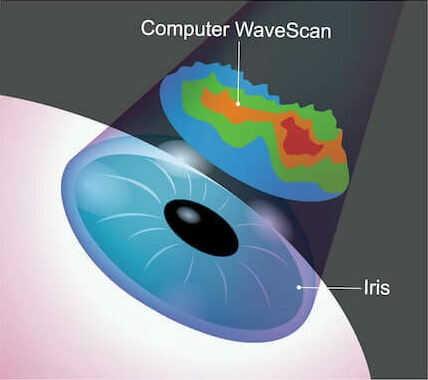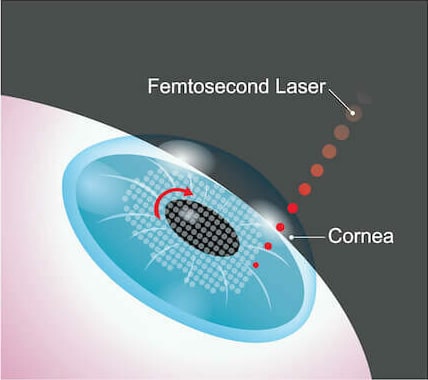LASIK
LASIK
LASIK Eye Surgery in Miami
We value your vision as much as you do, that’s why your eyes deserve one of the most advanced laser technologies available today.
When it comes to your vision, only the best will do. That’s why we remain committed to staying at the forefront of vision correction technology. There are many LASIK options to choose from, but only the iDESIGN system driven LASIK procedure offers an advanced, high-definition method of measurement that assesses your unique vision imperfections to help us create a 100% personalized vision treatment plan just for you.
LASIK powered by the iDESIGN system uses a unique process to map the eye’s entire visual pathway, not just the front of the eye (cornea), to make the procedure 100% personalized. This technology makes it possible to reduce or eliminate refractive errors including higher-order aberrations of the full optical system.
Our practice believes in providing patients with the best technology available. Technologies used worldwide and trusted by organizations with the highest safety standards, including NASA and the U.S. Military. Their elite personnel, including astronauts and fighter pilots, have relied on advanced technologies to improve their vision and reduce the need for glasses and contact lenses.
Whether it’s because you want to see in the middle of the night, to wake up to a clear view of your clock, participate in sports, or not to have lenses interfere with your daily activities, you have your own reasons for wanting your vision corrected.
How to Prepare for LASIK
Before LASIK, you’ll need to attend a consultation with your eye doctor at Center for Excellence in Eye Care. They will assess your candidacy for the procedure by asking questions about your visual goals, lifestyle, health history, and performing an eye exam.
This is a great time to ask questions about the procedure so you can be as prepared as possible. Your LASIK surgeon will likely recommend preemptive self-care practices like downloading music, podcasts, or audiobooks to listen to while you recover and rest your eyes, creating a comfortable, easily accessible place to relax, and preparing meals beforehand or using a meal delivery service so you won’t need to strain yourself in the kitchen.
You’ll also need to arrange transportation to and from the procedure and your first follow-up appointment, as it is unsafe to drive after LASIK until your eye doctor clears you.
LASIK with The iDESIGN System – The Brain of the Wavefront-guided Treatments
Your LASIK Procedure Just Got Smarter
**Contact lens costs are estimates and provided for comparison purposes only (based over 20 years). Your personal contact lens cost will vary. LASIK with the iLASIK technology suite cost is based on an estimated fee of $3,000 to $5,000 for both eyes.

How Does LASIK Work?

Step 1: Creating Your Eye Map
- The first step is to create a 3-D map of the imperfections of your eye using eye-mapping technology that measures how your eye processes light
- This technology captures more data (over 1,200 data points) than ever before to measure your eye’s unique imperfections and accurately plan a treatment that is uniquely yours
- It’s 25x more precise than conventional measurements, it even measures and captures imperfections that are not detected by conventional technology*
Precise measurement than with standard methods used for glasses and contact lenses. This map is used to drive the laser that corrects your vision.

Step 2: Preparing Your Eye
The second part of the procedure uses an ultrafast laser for creating a thin flap to prepare the cornea for treatment.
A 100% blade-free approach to creating your corneal flap – the thin flap of tissue that the doctor folds back in order to perform your LASIK procedure. The Intralase laser creates an extremely precise flap by producing tiny bubbles inside the cornea (clear front surface of the eye). The Intralase Method can only be performed using the FDA-approved Intralase laser.

Step 3: Delivering Your Personalized Treatment
Now that the corneal flap has been created, your vision can be corrected.
Step 3 involves an ultra-precise laser gently reshaping the cornea (front of your eye) to the desired curvature, based on the precise plan created by your personalized eye map.
Benefits of LASIK
Center for Excellence in Eye Care patients can look forward to LASIK benefits like:
Crisp, Clear Vision
By correcting your specific refractive errors with highly specialized lasers, many patients who undergo LASIK often enjoy even better vision than they had with glasses and contacts. Imagine seeing a vibrant sunset dipping below the horizon, smiling across the dinner table from your loved ones, or adding the finishing touches to an art project in vivid clarity!
Freedom From Visual Aids
LASIK can eliminate the frustrating hassles that come with glasses and contacts. No more scrambling for your frames with blurry vision, and no more irritation from wearing contact lenses all day; just stunningly clear vision from the moment you open your eyes to when you fall asleep at night.
Savings on Visual Aids
Although LASIK may seem more expensive than glasses and contacts initially, most patients ultimately save money by choosing the procedure. The cumulative costs over the years on glasses, contacts, repairs, backup pairs, cleaning supplies, and contact lens exams can add up to significantly more than the one-time cost of LASIK.
Center for Excellence in Eye Care also offers financing with programs like CareCredit, so you can set up monthly payments over time that easily fit into your budget.
Take The Next Step with iLASIK
- Schedule an evaluation with your iLASIK surgeon to determine if the LASIK procedure with the iDESIGN System is right for you.
- At your evaluation, you will be able to meet your surgeon and get answers to your questions.
- Schedule your iLASIK procedure and understand the post-surgery follow up visits.
You’re Probably A Candidate for LASIK with the iDESIGN System
Now that LASIK with the iDESIGN is available, there’s really no reason to put off having laser vision correction. LASIK technology is safe and proven. The reality is that the majority of people who meet the age and general health requirements are in fact good candidates for the LASIK procedure with the iDESIGN System. And the best part of the procedure is that it is fast and simple.
Like all surgery, LASIK surgery with the iDESIGN System has some risks we will discuss with you during your consultation. If you meet the basic requirements, you may be a candidate if:
- You are at least 21 years of age
- You are in good general health
- You have had a stable vision prescription for at least one year
- You have no existing eye disease
What to Expect During LASIK Recovery
Immediately after LASIK, you’ll be taken to an area to rest for about 30 minutes. Your eye doctor will monitor you to ensure you’re recovering properly, then clear you to be driven home by a family member or friend. During the first day of recovery, you should prioritize rest and try not to strain your eyes. Napping, listening to podcasts, or enjoying an audiobook can help you pass the time.
You may experience slight irritation and redness for a few hours after the procedure. However, it’s important not to rub your eyes as they are still healing. Your LASIK surgeon will provide you with an eye shield to wear while sleeping to avoid this. You should also avoid strenuous activity, going outside without UV protective eyewear, and getting water in your eyes.
LASIK FAQs
Don’t live in South Florida but want LASIK? No problem. We treat many patients from around the U.S. and internationally as well. We have several resources to share and can help you plan your visit. Please click here if you are an Out of Town Patient.
It’s Important to Include Safety Information
CONTRAINDICATIONS: You should not have LASIK if you have a collagen vascular (e.g., rheumatoid arthritis), autoimmune (e.g., lupus), or immunodeficiency diseases (e.g., AIDS) because they affect the body’s ability to heal. You should not have this procedure if you are pregnant or nursing; show signs of corneal abnormalities or corneal thinning; have symptoms of significant dry eyes; advanced glaucoma; and uncontrolled diabetes. If you have severely dry eyes, LASIK may increase the dryness, may delay healing after surgery, may or may not go away and it may result in poor vision after LASIK. WARNINGS AND PRECAUTIONS: LASIK is not recommended if you have cataracts, corneal scars, or dry eye syndrome; glaucoma; diabetes; severe allergies; history of Herpes simplex or Herpes zoster keratitis; are taking Isotretinoin (Accutane®), Sumatriptan (Imitrex®), Amiodarone hydrochloride (Cordarone®) or antimetabolites for any medical conditions; history of crossed eyes; previous corneal, intraocular surgery, LASIK or refractive surgery; family history of degenerative corneal disease; and history of inflammation of the eye. Your doctor will examine your eyes to determine if you are a candidate for this procedure. Talk to your doctor about any eye-related conditions, injuries, or surgeries you have had, any medications you are taking, and any changes to your vision in the past year. After surgery, you may find it more difficult to see in conditions such as dim light, rain, snow, fog, or glare from bright lights at night. Future measurements of your eye pressure or future cataract surgery can be affected by this procedure. Tell your future doctor you’ve had Advanced CustomVue LASIK surgery. RISKS: As with any surgical procedure there are risks associated with Advanced CustomVue LASIK treatments. It is important to discuss these risks with your doctor before you make any decision to have the surgery. If the results of the surgery are not satisfactory, your doctor may want to perform additional laser treatment in either one or both eyes. Talk to your doctor about what is best for you. Some risks are related to the creation of the corneal flap. Corneal flap complications include but are not limited to: cutting an incomplete, irregular flap or free flap; misalignment of the flap; and perforation of the cornea. Corneal flap complications range in severity from those that simply require the treatment to be postponed for several months, to those which create corneal irregularities resulting in permanently blurred vision. You may need reading glasses even if you did not wear them before. Your vision may not be perfect, and you may need to wear glasses or contact lenses for some activities even after laser vision correction. SIDE EFFECTS: Possible side effects include loss of vision and visual disturbances such as double vision, sensitivity to bright lights, increased difficulty with night vision, fluctuations in vision, and other visual irregularities that may be debilitating. Please consult with your eye care professional and carefully review the Patient Information Booklet regarding the potential risks and benefits of this procedure. Results may vary for each individual patient.
Reference:
- FDA approval P930016/S044, S045, S048. The National Eye Institute-Refractive Error Quality of Life instrument (NEI-RQL-42) was administered to subjects at the periodic study exams.
- Schallhorn SC, Venter JA, Hannan SJ, Hettinger KA. Outcomes of Wavefront-guided Laser in situ Keratomileusis Using a New-Generation Hartmann-Shack Aberrometer in Patients with High Myopia. J Cataract Refract Surg 2015; 41:1810–1819
*Compared to the WaveScan WaveFront® System.
- Schallhorn SC, Venter JA, Hannan SJ, Hettinger KA. Wavefront-guided Photorefractive Keratectomy with the Use of a New Hartmann-Shack Aberrometer in Patients with Myopia and Compound Myopic Astigmatism. J. of Ophth, volume 2015.
- Schallhorn SC, Brown M, Venter JA, Teenan D, Hettinger KA, Yamamoto H. Early Clinical Outcomes of Wavefront-Guided Myopic LASIK Treatments Using a New-Generation Hartmann-Shack Aberrometer. J Refract Surg. 2014;30(1):14-21.
*A phoropter is used for vision correction and measures errors in 0.25 diopter increments. iDESIGN® system wavefront measurements are in 0.01 diopter increments, making it 25x more accurate. These precise corrections are applied to the right spots on the cornea according to correction needed.
iDESIGN® System with STAR S4 IR® Laser
Indications and Important Safety Information
CAUTION: U.S. Federal Law restricts this device to sale, distribution, and use by or on the order of a physician or other licensed eye care practitioner. ATTENTION: Reference the Operator’s Manual for a complete listing of Indications and Important Safety Information. INDICATIONS: The STAR S4 IR® Excimer Laser System and iDESIGN® Advanced WaveScan Studio (iDESIGN®) System is indicated for wavefront‑guided LASIK in patients with myopia as measured by the iDESIGN® System up to -11.00 D SE, with up to -5.00 D cylinder, in patients with hyperopia as measured by the iDESIGN® System up to +4.0 D SE, with up to +2.00 D cylinder, and in patients with mixed astigmatism where the magnitude of the cylinder (1.0 D to 5.0 D) is greater than the magnitude of the sphere, and the cylinder and sphere have opposite signs; with agreement between manifest refraction (adjusted for optical infinity) and the iDESIGN® System refraction of 1) SE: magnitude of the difference is ˂ 0.625 D, and 2) cylinder: magnitude of the difference is ≤ 0.5 D; with patients 18 years of age and older, and with refractive stability (a change of ≤ 1.0 D in sphere or cylinder for a minimum of 12 months prior to surgery). CONTRAINDICATIONS: Laser refractive surgery is contraindicated for: patients with collagen vascular, autoimmune, or immunodeficiency diseases, pregnant or nursing women, patients with signs of corneal abnormalities including signs of keratoconus, abnormal corneal topography, epithelial basement membrane disease (EBMD) and degenerations of the structure of the cornea, patients with symptoms of significant dry eyes, patients whose corneal thickness would cause the anticipated treatment to violate the posterior 250 microns (μm) of corneal stroma, and in patients with advanced glaucoma, and uncontrolled diabetes. If the patients have severely dry eyes, LASIK may increase the dryness; this may or may not go away. Severe eye dryness may delay healing of the flap or interfere with the surface of the eye after surgery; it may result in poor vision after LASIK. WARNINGS AND PRECAUTIONS: LASIK is not recommended in patients who: have systemic diseases likely to affect wound healing, such as autoimmune connective tissue disease, diabetes or an immunocompromised status, have a history of Herpes simplex or Herpes zoster keratitis, have severe allergies or tendency rub their eyes often, have glaucoma, elevated IOP, ocular hypertension or being followed for possible glaucoma (glaucoma suspect), are taking the medication Isotretinoin (Accutane®), are taking antimetabolites for any medical conditions. The safety and effectiveness of this laser for LASIK correction have NOT been established in patients: with progressive refractive errors, ocular disease, corneal abnormality, previous corneal or intraocular surgery, or trauma in the ablation zone, who are taking the medication Sumatriptan (Imitrex®), or Amiodarone hydrochloride (Cordarone®), with corneal neovascularization within 1.0 mm of the ablation zone, over the long term (more than 1 year after surgery for myopia and more than 2 years for mixed astigmatism), for patients who engage in activities that could endanger or damage the LASIK flap, for patients who have a family history of degenerative corneal disease, history of inflammation of the eye, for patients who have a history of crossed eyes (strabismus) or who have undergone strabismus surgery, prior LASIK or Refractive Surgery, with history of any eye diseases or abnormalities such as corneal scars or active disease, and whose BSCVA is worse than 20/20. To reduce the risk of corneal ectasia, the posterior 250 microns (μm) of corneal stroma should not be violated. The treatment of highly myopic eyes necessitates the removal of significant amounts of corneal tissue. The iDESIGN® System calculates the estimated residual bed depth using the pachymetry and intended flap thickness entered by the user. Actual flap thicknesses may vary. If the estimated residual stromal bed is ≤ 320 microns, an in-the-bed pachymetric measurement should be performed. ADVERSE EVENTS: Possible adverse events include loss of best spectacle-corrected visual acuity (BSCVA), serious Transient Light Sensitivity Syndrome, serious primary open-angle glaucoma, miscreated flap, melting of the flap, severe glare, and severe dry eyes. Complications can include corneal edema, epithelial ingrowth, diffuse lamellar keratitis, foreign body sensation, and pain.
©2017 AMO Manufacturing USA, LLC. iLASIK, Advanced CustomVue, STAR S4 IR,
iDESIGN, and iDESIGN Advanced WaveScan Studio are trademarks owned
by or licensed to AMO Manufacturing USA, LLC. All other trademarks are the
intellectual property of their respective owners.PP2017RF0200






